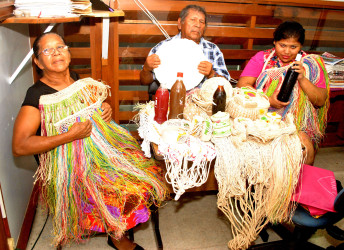Kabakaburi in the Pomeroon River is one of several typical Amerindian homesteads, populated by a few hundred people where logging has, over time, been the most reliable means by which the men earn a livelihood. Women weave their Tibisiri craft and prepare their traditional indigenous food and drink and hope for the best from the modest markets afforded by events like Indigenous Heritage Month in September and GuyExpo.
This week, the Callistros—Neville, Iris and their 22-year-old granddaughter Satusia—came to Georgetown to talk with Stabroek Business ahead of their participation in this month’s Business Exposition, an event for small businesses which, for this year alone, replaces GuyExpo. These days, the Callistros and several of the other families at Kabakuri, cannot afford to pass up the opportunity afforded by events like the Business Exposition.
At 71, Neville Callistro, a former Village Captain at Kabakuri and better known in an earlier time as the Mighty Chief is devoting more of his time to working with his wife and granddaughter to sustain their enterprise which, he says, produces “genuine Amerindian Products” under the trading name The Real Thing. Life has changed for the one-time popular entertainer following a stroke in 2000 and the loss of 5,000 acres of leased land in the Pomeroon to what he says was “political payback” by the previous administration.

The Callistros have been in the business of craft since 1972, their interest in the pursuit coinciding with the first Carifesta. They have returned to the trade in more difficult times brooding over the fact that up until now the national obligation to bring Amerindian culture to the core through its craft and its culture remains unfulfilled.
The problem, Callistro says, is that these days, the Amerindians have had to gravitate increasingly to pressing their creative skills into pursuits directly designed to subsidize their incomes. In the process what they have discovered, he says, is that the institutions that ought to have been put in place to support the growth and development of a sustainable Amerindian craft enterprise are nowhere to be found.
It is, he says, a matter of creating an enabling environment in which Amerindian craft can thrive as a commercially viable pursuit. There are, he points out, no institutions outside of the Amerindian communities for refining skills, packaging, labelling and marketing. “The visitors who might be interested in what we offer never find their way to places like Kabakuri,” Callistro says.
Politics, the Callistros say, has not always been kind to them. Over the years he has always been a prominent part of the Amerindian Heritage Month commemorative event. That, he says, came to an abrupt end following his active participation in a still unsettled community land issue at Kabakuri. “It was just victimization,” he says.
Iris is preoccupied with the Business Exposition. When she spoke, she wondered aloud as to whether a fee of $20,000 to have two booths at the event was not too steep. She points out that there is still no sustainable market for Amerindian craft and condiments and that the trade is still a matter of patronage. Vendors like those who must bring their goods from Kabakuri must balance their participation at these urban showpiece events against the high cost of getting there. Setting aside the high cost of travel to the city (there are no roads out of Kabakaburi and most of the journey must be undertaken by boat) there are the costs associated with remaining there for the duration of the event. Both Iris and her husband say that Amerindian vendors who travel from non-coastal communities still need subsidies if their micro enterprises are to be sustainable.
The upshot of the underdevelopment of the indigenous craft industry, Callistro says, is evident in some of the manifestations that obtain in the creative sector as a whole. He bemoans the fact that the Guyana Art and Craft Association has done little if anything for the upliftment of indigenous creative work, that the value-added associated with packaging, labelling and marketing is still to reach most Amerindian communities and that efforts to move Amerindian craft into the tourism mainstream continue to be relatively weak and ineffective. In the case of The Real Thing, the Callistros still struggling enterprise, it continues to be a manifestation of what Callistro believes is still a promise to the country’s Amerindian community that remains unfulfilled.




